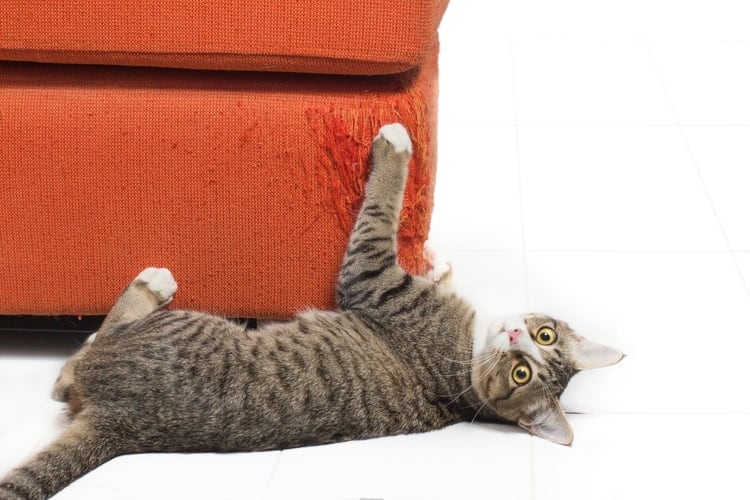No matter how much you love your cat and want them to feel at home with you, you still don’t want them to destroy your furniture. Marking their territory has to be in a way that doesn’t keep you from enjoying your home, too. But that may not be an easy sell for your little ball of clawed fur. The good news is you have choices on how to handle the scratching. There is no one right answer, but chances are you’ll find the answer (or more than one!) that suits your family best in our list below. Here’s what you need to do to stop your cat from scratching your furniture.
1. Understand Why Your Cat is Scratching
Once you know why your cat is scratching, you may find it easier to remain calm when you find some scratches where there shouldn’t be. Sometimes cats scratch for seemingly no reason, just when they stretch, when they’re bored, or to mark territory. But even if you take away those reasons (that are extra annoying), there are legitimate reasons cats scratch.
The biggest reason (and one we can sympathize with) is that their nails need to be maintained. Not only do they need to be sharpened, but they also need to shed any fraying that often happens on the outside layer. Without the scratching, they can develop infections or other long-term problems. Keep in mind, unlike human nails, cat’s nails are actually the last bones that extend off each of their toes. So maintaining these nails is all the more important. If you need some advice on how to keep your cat’s nails nice and short, check out this article on how to trim a cat’s nails.
2. Provide Alternatives
Any cat with nails needs to scratch, so rather than trying to keep them from scratching all together, you should just provide them alternatives. Redirect them to appropriate scratching places. For this, you’ll need to buy some scratching equipment. You can use a standard scratching post, or you can try a combination scratching toy that should both keep them entertained and allow them to scratch.
For more options, see our list of The Best Cat Scratching Posts.
To make sure your cat actually uses her new scratching post, you can spray it with honeysuckle or catnip. That will definitely peak her interest, and once she’s there, scratching will likely come instinctively. Encourage her actions as they occur to reinforce that behavior.
3. Clip Nails Regularly
If you want to avoid the excusable reasoning behind scratching as much as possible, you’ll need to take her paws into your hands – both literally and figuratively. Make sure you’re grooming her nails so she doesn’t have to. Trim her nails as needed, but be careful to trim only the curl of the nail (the white-only part). Be sure to avoid cutting the quick, or the pink vein that runs down the center of the inside. If you do accidentally snip it, there will be a bloody mess – and your cat is going to be less than enthusiastic about the next nail-trimming session.
Your cat’s nail growth may vary, but it’s generally recommended that a cat’s nails are trimmed every 10 days to two weeks. Keep an eye on your cat’s paws and scratching habits, though, and you may find she needs it less or more.
If you’ve never trimmed your cat’s nails before, here a guide to how to trim your cat’s nails.
4. Protect Your Home
You can try to correct behavior when you see it by gently and consistently pushing your cat away from the furniture as she’s scratching. That simple act alone goes a long way towards teaching them. Of course, a spray bottle full of water also works wonders. You may want to pick up a few and keep them spread out throughout your home.
There are some mixed reviews of sprays that keep cats away from furniture, and you may find a type that works for you. When looking for one, though, consider that you’ll want a spray that won’t spread to areas of the house the cat is allowed. For example, if you don’t want your cat scratching the legs of the couch but it’s okay for her to plop on the cushions, you’ll probably want to avoid spraying a deterrent there at all. You’ll also want to make sure you’re choosing a safe spray that won’t harm her. A spray with just an unpleasant herb or spice likely will suffice to keep kitty away.
If simple sprays aren’t working out, you can consider using cat pheromone diffusers around the house for a more potent way to ease your cat’s aggressive behavior.
When all else fails, and you just need to protect a piece of furniture, you may want to invest in some furniture protection. With this kind of stick-on layer, you’ll be able to put a barrier between your cat and the spot she’s marked as her favorite to scratch. For a less expensive alternative, you can also just place clear packing tape along the edges, but you will likely need to replace it more frequently. Double-sided sticky tape is another great option; the sticky texture will make your kitty avoid it at all costs.
If your cat happens to be targeting the sofa in particular, a more complete solution to protect the whole of it would be to use sofa covers. Getting one that is specifically made to protect against destructive cat scratching will ensure that your cat is unable to destroy the fabric.
Remember, during the process of ceasing your cat’s scratching habits, it will be easy to damage your relationship, so you’ll need to be careful. Act as calmly as you can, even when correcting behavior and be sure your cat is associating your negative feelings towards the action she’s doing (scratching) and that she isn’t developing an overall fear of you.
5. Declaw as a Last Resort
Declawing your cat is a big and controversial decision that shouldn’t be taken lightly. There are significant risks and complications involved that need to be considered. It’s worth noting that The Humane Society says, “It is an unnecessary surgery that provides no medical benefit to the cat. Educated pet parents can easily train their cats to use their claws in a manner that allows everyone in the household to live together happily.”
We recommend conducting thorough research into the topic and only declawing your cat as a very last resort. This site is a good place to start researching the pros and cons of declawing. Remember, there are many other alternatives, such as putting nail caps on your kitty and the other methods we’ve shared above, that have proven to be effective with many cat parents.




















